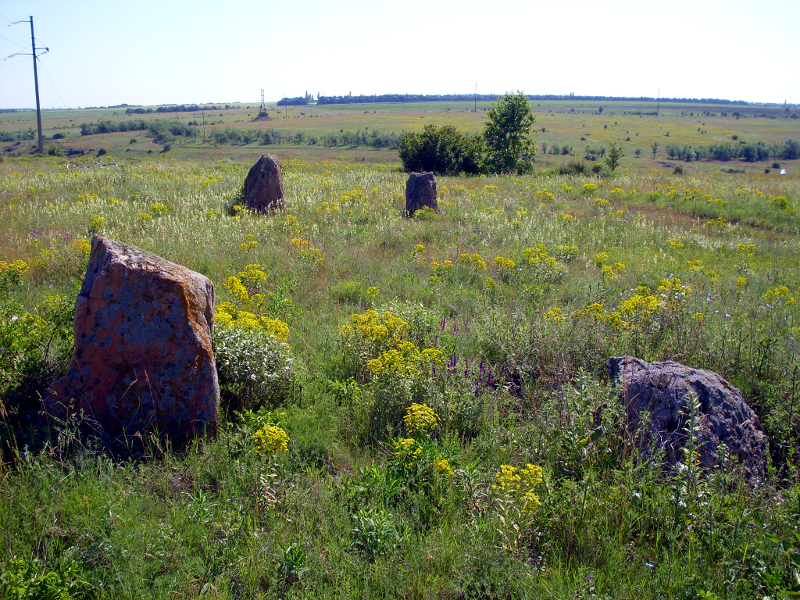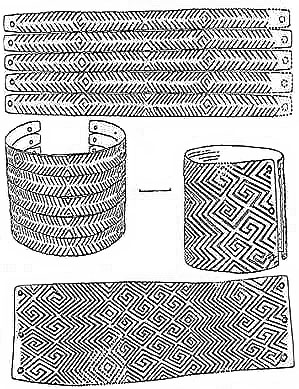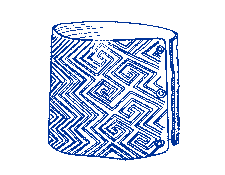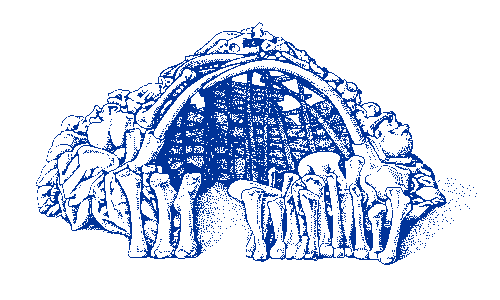
- •Picture 5. Menhir alley, Nechayivka villidge (slide 24)
- •(Slide 30) Trypillian culture.
- •Figure Stone carvings of the Scythian warriors
- •Question 2. Pantheon of gods.
- •I n the pantheon of Vladimir, the pagan deities were arranged in order of their seniority and each of them had similar antique gods and Christian saints.
- •Question number four. The gods and rituals.
Topic 2: Sources of Ukrainian culture (slide 1)
Plan
Early cultural forms in Ukrainian lands.
Trypillian culture.
Early Slavonic culture.
Heathen culture.
Nations and cultures origin are of special interest. As a result of numerous centuries existence Ukrainian people has created great culture and contributed a lot to world culture. Ukrainian culture history is long and complicated. It traces from the period of primitive society. Ukrainian culture is one of the most ancient European cultures. People appeared at this territory for about 300,000 (300 thousand) years ago.
A specific feature of primitive culture is syncretism (slide 2) (integrity) when the forms of consciousness, household activities, social life and art are not separated or opposed to each other. All kinds of activity were mutually related. For example, hunting integrated technological methods of weapon production, knowledge about animal habits, social contacts, expressed in hunting organization (individual, collective), religious beliefs – magic acts to ensure success, which, in its turn, included elements of art – songs, dances, painting. It is syncretism of primitive culture that provides an integral consideration of material and spiritual culture.
All the territory of modern Ukraine was settled in late Palaeolithic period (35-40 thousand years ago). During the Palaeolithic humans were hunting and foraging (gathering food, such as berries, plant roots and beets), they discovered a way of making fire. The basis of social order was a matriarchy.
Art appeared in Upper (or Late) Palaeolithic. Its rise was a great progress in the cognitive activities of people, their view on the world. Art strengthened social ties and helped the formation of the primitive community, became a means of transferring experience. Art of Upper Palaeolithic period (slide 3) is divided into cave paintings and portable art. Cave paintings are the images painted or engraved on the walls of caves and rock shelters. Portable art includes small-sized figurines or objects made of bone, horn, soft rock stone with painted or engraved pictures on them. These objects are “portable” as they could be brought from one place to another, stored, shared, used in rituals where it was necessary (for example, at sites, in sanctuaries, in places of hunting etc.) Works of cave art are stationary, i.e. they were available only where they were depicted. However, the cave and portable art are not mutually exclusive, as they are the visual reflection of the complex processes associated with spiritual life of the prehistoric man. Numerous objects of portable art are found on the sites, in caves during excavations and accidentally. Depictions on small, “portable” objects make the integral part of the Paleolithic art.
The forms of Palaeolithic art are quite different: petroglyphs (slide 4) (images of animals and people made on stone), (slide 5)engraving or prints on the bones and horns or flat objects, reliefs, drawings, clay and stone sculptures and statuettes or other three-dimensional objects cut out of soft stone or other materials (like mammoth’s tusk). Magical practices appeared. Most scientists say that magical religious beliefs created the need to convey the world by means of art. Ethnography knows many examples when the spell and dancing around the images were considered as a means of influence on real animals. Palaeolithic artists depicted mostly animals: bison, horses, deer and mammoths. The first pictures are imperfect, but artists became remarkably skilful later. Animals’ figures were drawn masterfully with proportions observed.
Small-sized female statuettes (slide 6) are also characteristic of the Stone Age. They differ in details, (slide 7) but are always done by one common principle: while limbs and facial features are just indicated, features of a mother-woman are outlined sharply. They have enormously large abdomens and represent pregnant women. (slide 8) These are statuettes of Makosh, Slavonic goddess of fertility and procreation, well-known to all Slavonic tribes of the 4th century B.C., which moved through Europe and Asia in late Stone Age. They are also figuratively called the “Palaeolithic Venus.” (slide 9) Almost all the specialists, who studied the Palaeolithic women’s statuettes, interpret them as cultic subjects, amulets, idols etc, reflecting the idea of maternity and fertility. Scientists explain them by the cult of Foremother – an ancestress, progenitress, or genetrix in tribal communities, where kinship was conducted maternally.
In Ukraine, many Paleolithic sites were examined. One of them is a site near Mizin village (slide 10) on the banks of the Desna River near Chernihiv. Its treasures include figurines that depict birds, an interesting bone bracelet covered with complex geometric patterns, and female statuettes. Jewelry was used by the Stone Age hunters of Europe and Asia by 30,000 B.C. A bracelet carved from a single piece of mammoth ivory found at Mizin, (slide 11) Ukraine has a magnificent design which can be found to this day in the embroidery of Ukrainian costumes and cloths. This bracelet dates back to 20,000 B.C. and the design is reminiscent of, but predates, the famous Greek meander.
The world's first set of musical instruments, which were used to accompany dancing, was found here. It is the famous Mizin rattle complex 5-unit bracelet, made of stone. The first ancient musical notes in the world are also found in Mizim (Picture 1) and at Mezhirich, near Kyiv (Picture 2). The earliest known musical instruments, according to some scholars also were found in Mezhirich. They were made of decorated mammoth bones. A mammoth skull was used as a kind of drum-like instrument. Pictures 1 and 2. Bracelet of mammoth (ivory) tusk from the XVIII century B.C. (20,000 B.C. found in Ukraine).
|
|
Picture 1 http://news.students.ru/index.php?newsid=11723; http://uk.wikipedia.org/ |
Picture 2 http://newvv.net/culture/Culture/193229.html |
(slide 12) The oldest known house in the world is a remarkable dwelling found at Mezhirich, near Kyiv, the capital of Ukraine. It was found in 1965 by a Ukrainian farmer who was digging a new cellar six feet below his home. It is made of mammoth bones and was built about 15,000 years ago. It formed part of a village and was so strongly built that it would have lasted several generations. (slide 13) The other ancient dwelling of the same type is found in Mizin. This would indicate that the inhabitants were settled agriculturalists rather than nomad hunters. In Kostienki, Ukraine, there was a huge house from the same period which measured 115 feet by 50 feet with eleven hearths for cooking, warmth and light (Ancient Inventions of Ukraine by Andrew Gregorovich p. 434-35// http//www.infoukes.comhistory). Pictures 3, 4. Dwelling made of mammoth bones.
|
|
Picture 3 Mizyn site, Chernihiv region // http://newvv.net/culture/Culture/193229.html |
Picture 4 Mezhirich, near Kyiv // Ancient Inventions of Ukraine by Andrew Gregorovich p. 434-35 // http//www.infoukes.comhistory |
(slide 14) In the transition period, the Mesolithic one (10,000 – 7,000 years BC) fishing began to develop; a man domesticated a dog and invented a bow. Formation of the primitive tribal organization started in the Mesolithic period. Archaeological discoveries prove, that ancient people practiced not only primitive cults associated with hunting and foraging, but also a more developed cult – the worship of ancestors, which at that time was associated with the idea of motherhood, family and its progenitor, and corresponded to matriarchal principles of social relations.
(slide 15) The general nature of art remained, if compared to the previous stage, but, unlike in Palaeolithic paintings, the leading role in Mesolithic ones belongs to a man and his activities. Compositions differ by their plot: hunting, dance, etc. The artists were already seeking to convey the inner meaning, the dynamics of an action.
Neolithic Age started 7,000 years ago at this territory. It had existed up to the 3rd millennium B.C. Sometimes scientists name the changes of this age as Neolithic revolution. (During this period collective form of economic activity passed into the productive forms of labour: hoe agriculture and stock-raising. Population, living at the territory of Ukraine at those times moves to farming – it practiced sowing millet, barley, wheat, oats and domesticated cattle, sheep, goats, horses. People produced pottery and fabrics. They started to use fire; language and thinking arose.)
(slide 16) Productive forms of labour deepened a man’s knowledge about nature, which resulted in appearance of generalizing notions and new world order understanding. Human life at Neolithic age depended on rich or poor harvest, good or bad weather. People started to think of natural phenomena, they felt necessity to embody in art the sky, the Sun, water, fire, the earth. New symbols appeared: a cross, (slide 17) a spiral, a triangle(slide 18), a rhombus (a diamond), (slide 19) swastika (swastika appeared at Upper Palaeolithic ornaments of ancient peoples of the East and was one of the most spread decorative elements, connected with the Sun, fertility, generosity and the good). (slide 20) Figures of animals, birds and people also became symbolic signs, difficult to decipher. (slide 21) In Neolithic realistic images were almost completely changed by abstract motives embodied in ornament.
Neolithic people wanted to decorate almost everything that surrounded them: ceramics was covered with ornaments, wooden things were decorated with carvings, painted clay statuettes demonstrate the kinds of ancient fabrics. Personal jewellery and personal ornaments were numerous: necklaces, bracelets, rings, body were painted or tattooed. An ornamental art (Arts and Crafts) is the main attribute of Neolithic art. Primitive arts started to form at this period (mostly round sculpture and relief), music and dancing, and painting. Primitive people had practical knowledge in medicine, pharmacology, toxicology that gave them the chance to treat fractures, dislocations, wounds and injuries.
(slide
22)  Megaliths.
An important and fundamentally new phenomenon that characterizes
almost universally late Neolithic period and then the Bronze Age, is
a megalithic architecture (“megalith” from the Greek "a big
stone"). It is an evidence of both the increased technical
possibilities, and the new aesthetic and ideological needs of people.
Previously, people had acquired some experience in housing: dug-out
huts of Paleolithic time, clay houses of Trypillia culture. But those
buildings were purely utilitarian, practical, while megaliths are
associated with a religious cult. Megalithic structures were of
several types:
(slide 23)
Megaliths.
An important and fundamentally new phenomenon that characterizes
almost universally late Neolithic period and then the Bronze Age, is
a megalithic architecture (“megalith” from the Greek "a big
stone"). It is an evidence of both the increased technical
possibilities, and the new aesthetic and ideological needs of people.
Previously, people had acquired some experience in housing: dug-out
huts of Paleolithic time, clay houses of Trypillia culture. But those
buildings were purely utilitarian, practical, while megaliths are
associated with a religious cult. Megalithic structures were of
several types:
(slide 23)
menhir – a vertical stone, sometimes up to 20 m height; in France there are fields of pillars extending to 2-3 km, they were either the subject of worship, or marked the place of ceremonies;
Picture 5. Menhir alley, Nechayivka villidge (slide 24)
dolmen – a stone box, its simplest variant – two vertically placed flat stones, covered with a third one; dolmens usually served as a burial place of family members; (slide 25)
cromlech – stone slabs or pillars, arranged in a circle; some of numerous mounds (kurgans) found in Ukraine (namely in Donetsk region), are surrounded by cromlechs. /Mound, Barrow, also Grave – a burial monument, an artificial hill, a mound of an ancient burial. / see Picture 6.
I |
Neolithic sites are all over Ukraine. (slide 26) The most interesting ones are the Mariupol burial mound in Donetsk region and the Stone Tomb near Melitopol, Zaporizhzhya region. The former contains fragments of instruments, jewellery, money and ancient weapon made of stone, shell, bones and even copper. (slide 27) The latter has over a hundred rock carvings of 15 animal species and hunting scenes.
(slide 28) In the Eneolithic Age (Bronze-Stone Age) people started to use bronze to produce jewellery and weapons, which caused fundamental changes in society. Military leaders and a leader cult appeared. The special treatment of the leader as a hero remained after his death. It is in the metal era that burial sites – mounds became usual. Dimensions of mounds, the number and quality of things, they contained, confirm the status of the dead in society. Thus, megalithic architecture got further development. Many of the Bronze Age burial mounds were studied in Ukraine.
Metal processing required great skill and expertise, that is why so casting became an independent branch as well as pottery and weaving. Metal art/craft was one of the main types of work. A man soon mastered various types of metal art: smith (forging), casting, chasing, and engraving on metal. A variety of metal jewellery was produced: bracelets, rings, earrings, pendants (підвіски), plaques (бляшки) that were sewn on garments, belts, buckles. Particular attention was given to weapons. Small cast sculptures appeared. The fact that women images started to disappear, but a male image became the leading one, prove the changes which occurred in the social system.
(slide 29) This historical period was a starting point to further differentiation between three economic areas on territories of modern Ukraine. The Right Bank was the cradle of Trypillia arable farming culture, the steppe south – of cattle breeding, associated with the tribes of the so-called Yamna Culture, who led a nomadic way of life in the steppes from the Dnestr to the Trans-Urals in Russia. Stockbreeders also lived alongside with hunters and fishermen in the forests and forest-steppes (Sredneostogovskaya Culture 4-3 B.C.). A bright example of Eneolithic culture in the territory of modern Ukraine is Trypillia archaeological culture.





 n
the Russian-language literature a kind of a megalithic stone
circle is usually called "a cromlech". At the same time,
the word "cromlech" derives from the Celtic "crwm"
(vaulted) and "llech" (stone floor). It corresponded
dolmen-like structures. Therefore, in Wales, and partly across the
UK, cromlech is what in Russian is called a dolmen. A ringed stone
structure in English tradition is called a "stone circle".
The same importance is the term "henge."
http://pravdaua.at.ua/publ/6-3-2
Picture
6
Cromlech on Khortytsya Island, Zaporizhzhya.
n
the Russian-language literature a kind of a megalithic stone
circle is usually called "a cromlech". At the same time,
the word "cromlech" derives from the Celtic "crwm"
(vaulted) and "llech" (stone floor). It corresponded
dolmen-like structures. Therefore, in Wales, and partly across the
UK, cromlech is what in Russian is called a dolmen. A ringed stone
structure in English tradition is called a "stone circle".
The same importance is the term "henge."
http://pravdaua.at.ua/publ/6-3-2
Picture
6
Cromlech on Khortytsya Island, Zaporizhzhya.